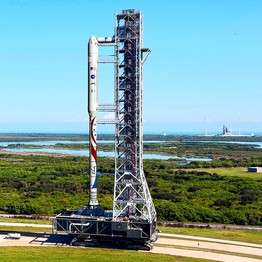Next Generation Launcher
 Artist's rendering of Liberty rocket, on which NGL is based | |
| Manufacturer | Orbital ATK |
|---|---|
| Country of origin | United States |
| Size | |
| Height | 90.00 m (300 ft) |
| Diameter |
3.71 m (12.17 ft) First Stage 5.25 m (17.2 ft) Upper Stage |
| Stages | 3 |
| Capacity | |
| Payload to GTO | 5,500+ kg (12,125+ lb) |
| Associated rockets | |
| Family | Preceded by Liberty |
| Launch history | |
| Status | Under Development |
| Launch sites | Kennedy LC-39B and Vandenberg SLC-2 |
| Total launches | 0 |
| Successes | 0 |
| Failures | 0 |
| Partial failures | 0 |
| First flight | 2020 (projected) |
| Boosters - GEM-63 or GEM-63XL | |
| No. boosters | 0 to 6 |
| Diameter | 1.6 m (63 in) |
| Specific impulse | 279.3 seconds (2.739 km/s) |
| Fuel | HTPB |
| First stage | |
| Engines | Castor 600 2-segment Shuttle-derived Solid Rocket Booster |
| Fuel | Solid |
| Second stage | |
| Engines | Castor 300 1-segment Shuttle-derived Solid Rocket Booster |
| Fuel | Solid |
| Third stage | |
| Engines | 1 × BE-3U |
| Thrust | 534 kN (120,000 lbf) |
| Specific impulse | >400 seconds (vacuum) |
| Burn time | unknown |
| Fuel | LOX/LH2 |
Next Generation Launcher is a launch vehicle concept proposed by Orbital ATK as an EELV replacement program intended for national security and commercial satellites.
Next Generation Launcher is similar to the defunct Ares I and Liberty projects, both of which consisted of a five segment Space Shuttle Solid Rocket Booster (SRB) and a cryogenic second stage. Ares I would have combined a five-segment SRB with a J-2X powered second stage, while Liberty would have combine a five-segment SRB with the core stage of the European Ariane 5 as a second stage. By comparison, Next Generational Launcher consists of Space Shuttle-derived solid stages with a cyrogenic upper stage provide by Blue Origin.[1] It is intended to be launched from Kennedy Space Center LC-39B or Vandenberg Air Force Base SLC-2.[2]
Next Generation Launcher is proposed as a vehicle to launch national security satellites for the United States Air Force, and could potentially launch other government and commercial payloads, including to Geostationary transfer orbit.
History
In January, 2016, Orbital ATK was one of two companies awarded funds by the United States Air Force to develop technologies to eliminate dependency on the Russian-made RD-180 rocket engine.[3] The award was worth an initial $46.9 million, with an option for up to $180.2 million total. This is to be matched by $31.1 million initially, and up to $124.8 million in company funds if all options of the contract are exercised. The contract will fund the development of three technologies in support of the Next Generation Launcher: the GEM-63XL strap-on booster, the Shuttle-derived Common Booster Core and an extendable nozzle for the BE-3U upper stage engine. A previous effort, funded by NASA, demonstrated the technology for a composite motor case for Shuttle-derived boosters to replace the metal motor cases used during the Space Shuttle program.[4]
In May, 2016, Orbital ATK revealed their plans for the Next Generation Launcher, including the configuration and the intended business case.[2] In addition to relying on Shuttle-derived boosters, the Next Generation Launcher intends to make use of existing launch infrastructure at Kennedy Space Center, including the Vehicle Assembly Building used by the Space Shuttle, with the possibility of polar orbit launches occurring from Vandenberg Air Force Base. Orbital ATK claimed that a minimum of 5-6 launches per year would be required to make the rocket profitable. Full development and introduction will be dependent on both demand and funding from the US Air Force.
References
- ↑ "Orbital planning new rocket to compete for U.S. military launches".
- 1 2 Clark, Stephen. "Details of Orbital ATK's proposed heavy launcher revealed – Spaceflight Now".
- ↑ "Orbital ATK, SpaceX Win Air Force Propulsion Contracts - SpaceNews.com". 13 January 2016.
- ↑ "One-on-One with ATK's Charlie Precourt about composite materials and NASA's Space Launch System - SpaceFlight Insider".